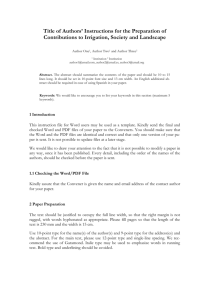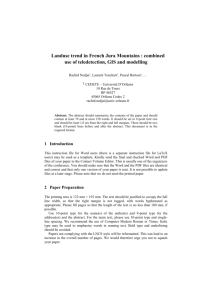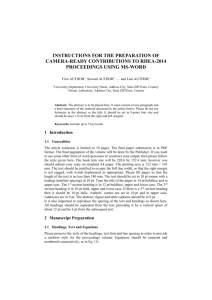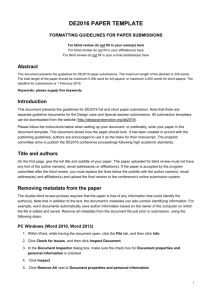official conference proceeding template
advertisement
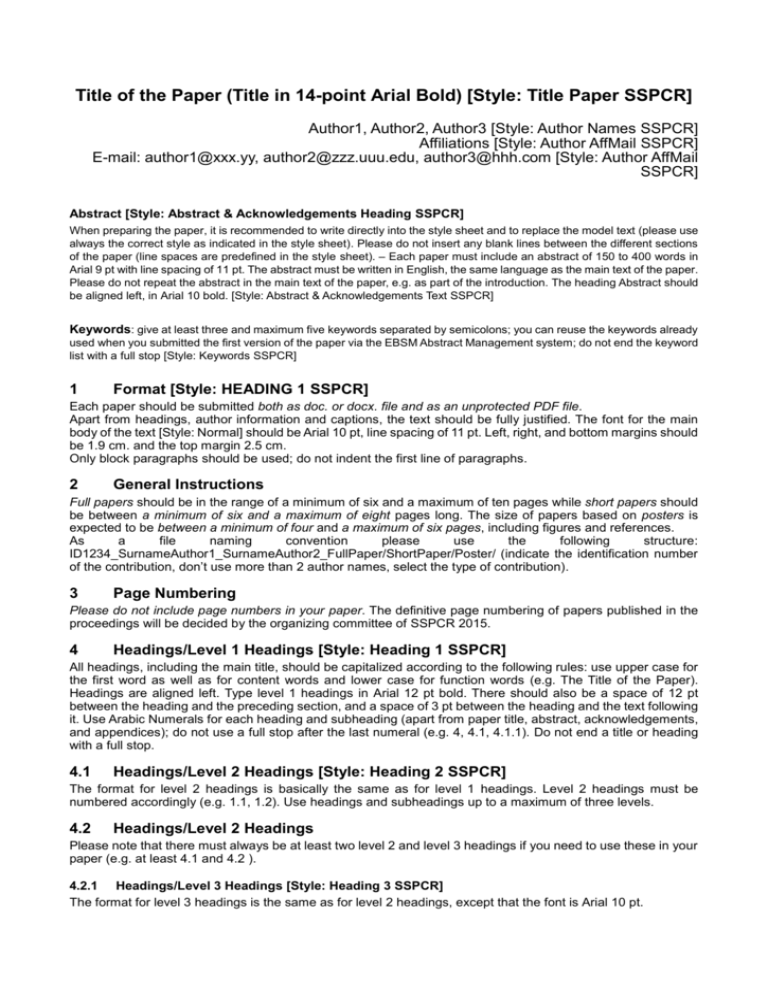
Title of the Paper (Title in 14-point Arial Bold) [Style: Title Paper SSPCR] Author1, Author2, Author3 [Style: Author Names SSPCR] Affiliations [Style: Author AffMail SSPCR] E-mail: author1@xxx.yy, author2@zzz.uuu.edu, author3@hhh.com [Style: Author AffMail SSPCR] Abstract [Style: Abstract & Acknowledgements Heading SSPCR] When preparing the paper, it is recommended to write directly into the style sheet and to replace the model text (please use always the correct style as indicated in the style sheet). Please do not insert any blank lines between the different sections of the paper (line spaces are predefined in the style sheet). – Each paper must include an abstract of 150 to 400 words in Arial 9 pt with line spacing of 11 pt. The abstract must be written in English, the same language as the main text of the paper. Please do not repeat the abstract in the main text of the paper, e.g. as part of the introduction. The heading Abstract should be aligned left, in Arial 10 bold. [Style: Abstract & Acknowledgements Text SSPCR] Keywords: give at least three and maximum five keywords separated by semicolons; you can reuse the keywords already used when you submitted the first version of the paper via the EBSM Abstract Management system; do not end the keyword list with a full stop [Style: Keywords SSPCR] 1 Format [Style: HEADING 1 SSPCR] Each paper should be submitted both as doc. or docx. file and as an unprotected PDF file. Apart from headings, author information and captions, the text should be fully justified. The font for the main body of the text [Style: Normal] should be Arial 10 pt, line spacing of 11 pt. Left, right, and bottom margins should be 1.9 cm. and the top margin 2.5 cm. Only block paragraphs should be used; do not indent the first line of paragraphs. 2 General Instructions Full papers should be in the range of a minimum of six and a maximum of ten pages while short papers should be between a minimum of six and a maximum of eight pages long. The size of papers based on posters is expected to be between a minimum of four and a maximum of six pages, including figures and references. As a file naming convention please use the following structure: ID1234_SurnameAuthor1_SurnameAuthor2_FullPaper/ShortPaper/Poster/ (indicate the identification number of the contribution, don’t use more than 2 author names, select the type of contribution). 3 Page Numbering Please do not include page numbers in your paper. The definitive page numbering of papers published in the proceedings will be decided by the organizing committee of SSPCR 2015. 4 Headings/Level 1 Headings [Style: Heading 1 SSPCR] All headings, including the main title, should be capitalized according to the following rules: use upper case for the first word as well as for content words and lower case for function words (e.g. The Title of the Paper). Headings are aligned left. Type level 1 headings in Arial 12 pt bold. There should also be a space of 12 pt between the heading and the preceding section, and a space of 3 pt between the heading and the text following it. Use Arabic Numerals for each heading and subheading (apart from paper title, abstract, acknowledgements, and appendices); do not use a full stop after the last numeral (e.g. 4, 4.1, 4.1.1). Do not end a title or heading with a full stop. 4.1 Headings/Level 2 Headings [Style: Heading 2 SSPCR] The format for level 2 headings is basically the same as for level 1 headings. Level 2 headings must be numbered accordingly (e.g. 1.1, 1.2). Use headings and subheadings up to a maximum of three levels. 4.2 Headings/Level 2 Headings Please note that there must always be at least two level 2 and level 3 headings if you need to use these in your paper (e.g. at least 4.1 and 4.2 ). 4.2.1 Headings/Level 3 Headings [Style: Heading 3 SSPCR] The format for level 3 headings is the same as for level 2 headings, except that the font is Arial 10 pt. 5 References in the text All references within the text should be placed in parentheses containing the author's surname followed by the date of publication (Verlinde 2009). If the sentence already includes the author's name, then it is only necessary to put the date in parentheses: Verlinde (2009). When citing several authors, use a semicolon to separate the references: (Verlinde 2009; Atkins & Rundell 2008). For citing page numbers use the following format: (Rundell 2012: 49) or (Rundell 2012: 49-51). When the reference has more than three authors, only cite the name of the first author followed by et al. 6 Citations Short citations up to 1-2 lines are embedded in the main body of the text using quotation marks: “Metalexicography is a broad discipline […]” (Rundell 2012: 49). Longer citations should form a separate paragraph; use Arial 9 pt, line spacing of 11 pt, and spaces of 6 pt before and 6 pt after the citation. Do not use quotation marks; the reference must be put at the end of the citation without any punctuation mark following it: Metalexicography is a broad discipline, taking in subjects such as dictionary criticism, dictionary typology, the history of lexicography, and the description of dictionary microstructures. These are all valid areas of study. The question for practising lexicographers is how far [my italics] any of this impacts on how they do their jobs or helps them to produce better dictionaries. (Rundell 2012: 49) [Style: Citation SSPCR] Use double quotation marks for short citations but also for terms and expressions that are used in a special sense (occasional meaning), e.g. a “harmless drudgery”. For quotations within quotations use single quotation marks, e.g. “[...] ‘harmless drudgery’ […]”. Omissions should be signalled with three dots within square brackets: […]. Square brackets are also used to signal remarks by the author (see citation example above: [my italics]). 7 Emphasis and Foreign Words Use italics for foreign language and emphasis. Please refrain from the use of FULL CAPS, bold type and underlining. 8 Figures and Tables 8.1 Figures All figures should be centred and clearly readable [Style for figures: Figure holder SSPCR]. Colour figures are allowed. Figures should be supplied in a clean and high quality format, using, if possible, a resolution of a minimum of 300 dpi. Figures should be numbered; place captions in Arial 9 pt beneath the figure. Spacing of captions should be set at 6 pt before and 6 pt after. End each caption with a full stop. Example: Figure 1: Caption [Style: Caption Table & Figure SSPCR]. Figure and caption should always appear together on the same page. 8.2 Tables The instructions for tables are the same as for figures (see previous section) [Style for tables: Table SSPCR]. Number tables and figures consecutively (Figure 1, Figure 2, etc., Table 1, Table 2, etc.). Example: Headword corpus Wordclass noun Domain label linguistics Table 1: Caption [Style: Caption Table & Figure SSPCR]. Each table and figure has to be referred to in the main text (see table 1). 9 Footnotes Footnotes are indicated in the text by a number in superscript.1 Please note that superscript numerals follow punctuation marks. 10 Lists Items in lists should be preceded by a dot; the dots are not intended; the text after the dot is hanging at 1.1 cm; otherwise the same rules apply as in the formatting of examples; e.g.: projects [Style: List SSPCR] planning tools [Style: List SSPCR] 11 Conclusion The SSPCR 2015 proceedings are published by EURAC, Institute for Renewable Energy, as a digital version. The proceedings will be given an ISBN number. Authors of contributions to SSPCR 2015 will be asked to sign a release document for publication. We remind you that it is in the author’s responsibility to obtain any permission required for the use of material owned by others. A separate document to be signed and returned to the Congress organizers before the publication is available for download. 12 References Bibliographical references should be listed in alphabetical order at the end of the paper. The title of the section, References, should be a level 1 heading. The first line of each bibliographical reference is not indented whereas the rest of the entry should be indented by 0.50 cm. The following examples of references illustrate the basic format required for conference proceedings, books, journals, articles, Ph.D. theses, and chapters of books respectively. When referring to online sources please do not forget to indicate the date on which you have accessed it at the end of the reference, using square brackets [dd/mm/year]. Arhar, Š., Gorjanc, V. & Krek, S. (2007). FidaPLUS corpus of Slovenian. The New Generation of the Slovenian Reference Corpus: Its Design and Tools. In Proceedings of the Corpus Linguistics Conference, CL2007, 2730 July 2007. University of Birmingham, UK. [Style: References SSPCR] Atkins, S.B.T., Rundell, M. (2008). The Oxford Guide to Practical Lexicography. Oxford: Oxford University Press. Verlinde, S. (2009) The Base lexicale du français: a multi-purpose lexicographic tool. In S. Granger, M. Paquot (eds.) eLexicography in the 21st century: New challenges, new applications, Proceedings of eLex 2009, Louvain-la-Neuve, 22-24 October 2009. Louvain-la-Neuve: Presses Universitaires de Louvain, pp. 335-342. Krishnamurthy, R. (2008). Corpus-driven lexicography. In International Journal of Lexicography, 21(3), pp. 231242. Kosem, I. (2010). Designing a model for a corpus-driven dictionary of Academic English. PhD thesis. Aston University, Birmingham, UK. Macmillan English Dictionary Online. Accessed at: http://www.macmillandictionary.com [07/02/2015]. Acknowledgements (optional) [Style: Abstract & Acknowledgements Heading SSPCR] Place all acknowledgements (including those concerning research grants and funding) in a separate section after the reference section. The format used for the acknowledgements is the same as for the abstract [Style: Abstract & Acknowledgements Text SSPCR]. They should be in Arial 9 pt, and appear at the bottom of the same page as their corresponding number. Footnotes should also be separated from the rest of the text by a horizontal line of 5 cm [Style: Footnote Text SSPCR]. 1 Appendix (optional) [Style: Abstract & Acknowledgements Heading SSPCR] Place all appendices in a separate section at the end of the paper. The format used for this section is the same as for the abstract. If you use more than one Appendix multiply the section using the following heading names: Appendix 1, Appendix 2, etc.

